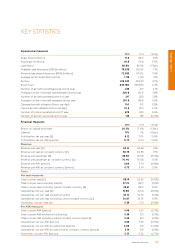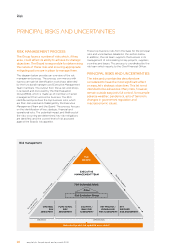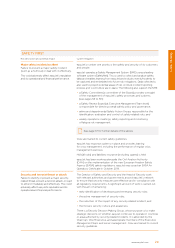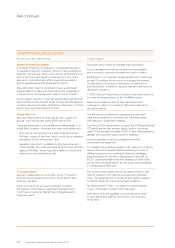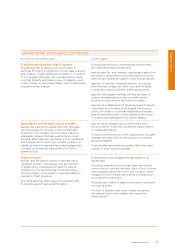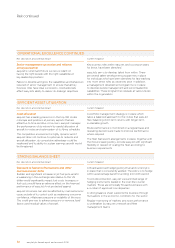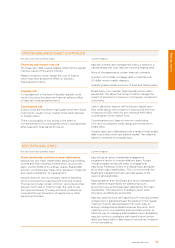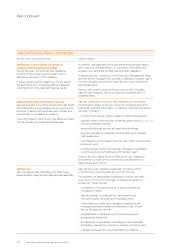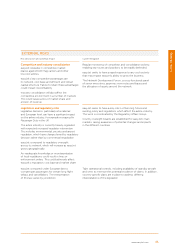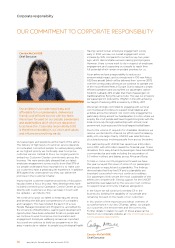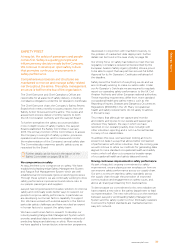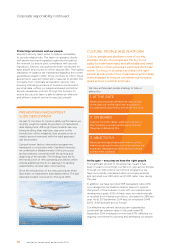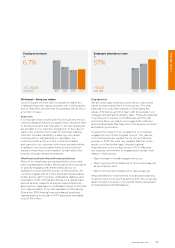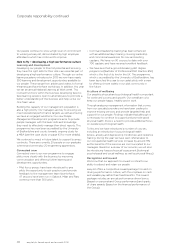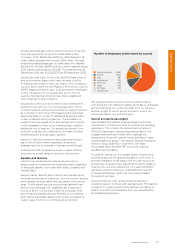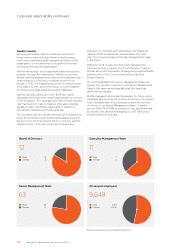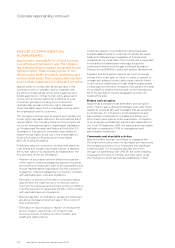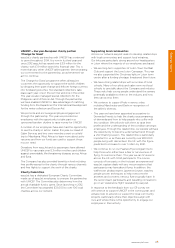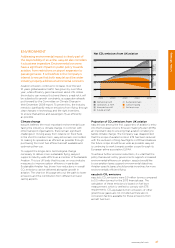EasyJet 2014 Annual Report Download - page 39
Download and view the complete annual report
Please find page 39 of the 2014 EasyJet annual report below. You can navigate through the pages in the report by either clicking on the pages listed below, or by using the keyword search tool below to find specific information within the annual report.
SAFETY FIRST
At easyJet, the safety of passengers and people
comes first. Safety is a guiding principle and
influences every decision made by the Company.
We continue to develop an open safety culture
that promotes continuous improvements in
safety performance.
Comprehensive processes and structures are
maintained to monitor and manage safety-related
risk throughout the airline. The safety management
structure is led from the top of the organisation.
The Chief Executive and Chief Operations Officer are
responsible for all aspects of safety delivery, including
compliance obligations under the Air Operator’s Certificate.
The Chief Executive chairs the Company’s Safety Review
Board which meets monthly to assess reports from the
Safety Action Groups across the airline. This review and
assessment process delivers monthly reports to both
the UK Civil Aviation Authority and the easyJet Board.
To further strengthen the safety structure and allow
more in-depth review of safety matters, the easyJet
Board established the Safety Committee in January
2013. The primary function of the Committee is to assess
the Company’s oversight of safety systems, processes,
operations and resources, and to review and monitor
the implementation of the Company’s annual safety plan.
The Committee also examines specific safety issues as
requested by the Board.
Further details can be found in the report of the
Safety Committee on pages 58 to 59
No compromise on safety
At easyJet there is no compromise on safety. We have
established a leading-edge Safety Management System
and Fatigue Risk Management System which are well
established and incorporate rigorous reporting processes.
Through these systems we are continually working to drive
safety performance improvements and reduce risks to
our people, passengers and suppliers.
easyJet has long pioneered innovative solutions to improve
safety and continually seeks better ways to support our
people to improve safety performance. In particular we
are developing our human factors capability to support
this. We have worked with external experts in the field on
particular safety challenges and have recruited an expert
in human factors to support the safety team.
We have used human factors research to develop our
industry-leading Fatigue Risk Management System which
provides analytical data to determine reliable methods of
predicting fatigue and alertness in pilots. More recently
we have applied a human factors intervention programme,
developed in conjunction with Cranfield University, to
the problem of inadvertent slide deployment. Further
details can be found in the case study on page 38.
Our strong focus on safety has helped us meet the new
regulatory compliance requirements prescribed by the
European Aviation Safety Agency (EASA). We are proud
to be able to report that easyJet has secured full EASA
Approval for its Air Operator’s Certificate well ahead of
the deadline.
Safety lies at the forefront of everything we do and we
are continually working to make our airline safer. Under
our Air Operator’s Certificate we are required to regularly
report our operating safety performance to the UK Civil
Aviation Authority and other European national authorities.
These reporting requirements differ from more standard
occupational health and safety metrics such as the
Reporting of Injuries, Diseases and Dangerous Occurrences
Regulations (RIDDOR) in the UK. Many occupational
health and safety requirements do not apply to airlines
in the same way.
This means that although we capture and monitor
all incidents and injuries to our people and passengers
wherever they happen, the way in which we have
reported on our operating safety does not align with
other industries’ reporting and is not in a format familiar
to many of our stakeholders.
To address this issue, we have been looking at how to
present our data in a way that allows better comparison
of performance with other industries. Over the coming year
we will continue to refine our methods for generating data
aligned to more standard occupational health and safety
metrics which will allow us to present a broader range
of occupational health and safety data and trends.
Driving continuous improvement in safety performance
As part of easyJet’s ongoing commitment to safety
improvement, we are placing a new emphasis on how we
can improve safety performance across our supply chain.
Our aim is to ensure seamless safety standards across
the supply chain through the promotion of improved
communication and engagement on safety issues, and,
above all, sharing and learning from best practice.
To demonstrate our commitment to this new initiative we
have created a new role in the safety department to lead
its implementation. The new role will focus on the interface
between easyJet’s world-leading Safety Management
System and the safety systems of our third-party suppliers
to ensure the highest standards are maintained across
easyJet’s network.
www.easyJet.com
37
Strategic report


